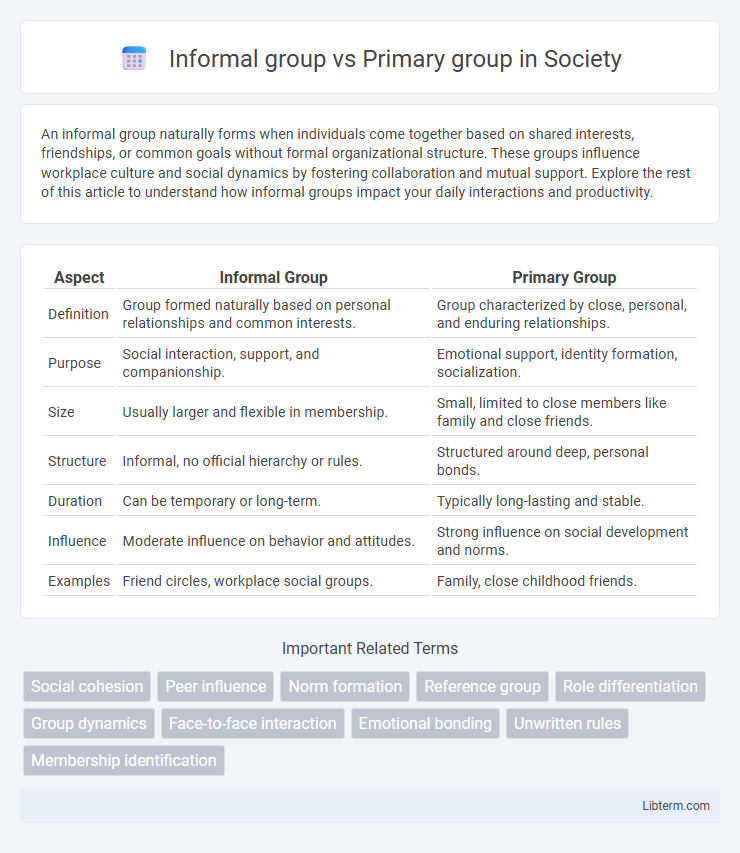An informal group naturally forms when individuals come together based on shared interests, friendships, or common goals without formal organizational structure. These groups influence workplace culture and social dynamics by fostering collaboration and mutual support. Explore the rest of this article to understand how informal groups impact your daily interactions and productivity.
Table of Comparison
| Aspect | Informal Group | Primary Group |
|---|---|---|
| Definition | Group formed naturally based on personal relationships and common interests. | Group characterized by close, personal, and enduring relationships. |
| Purpose | Social interaction, support, and companionship. | Emotional support, identity formation, socialization. |
| Size | Usually larger and flexible in membership. | Small, limited to close members like family and close friends. |
| Structure | Informal, no official hierarchy or rules. | Structured around deep, personal bonds. |
| Duration | Can be temporary or long-term. | Typically long-lasting and stable. |
| Influence | Moderate influence on behavior and attitudes. | Strong influence on social development and norms. |
| Examples | Friend circles, workplace social groups. | Family, close childhood friends. |
Understanding Informal Groups
Informal groups are social clusters formed naturally among individuals based on shared interests, personal relationships, or common goals, contrasting with primary groups that emphasize close-knit, emotionally intense bonds such as family. Understanding informal groups involves recognizing their role in shaping workplace dynamics, influencing behavior, and fostering communication outside formal organizational structures. These groups can significantly impact attitude, morale, and information flow, making them critical for organizational development and team management.
Defining Primary Groups
Primary groups are small, close-knit social units characterized by intimate, face-to-face interactions and strong emotional bonds. These groups, such as family and close friends, play a crucial role in shaping an individual's identity, socialization, and support system. Unlike informal groups, primary groups provide enduring relationships that influence members' values, behaviors, and psychological development.
Key Differences Between Informal and Primary Groups
Informal groups form naturally based on personal relationships and shared interests, while primary groups consist of close-knit, enduring relationships essential for social identity, such as family and close friends. Informal groups lack structured roles and formal organization, whereas primary groups involve strong emotional bonds, intimate interaction, and long-term commitment. The key differences lie in the level of intimacy, purpose, and social significance, with primary groups providing foundational emotional support compared to the more casual, situational nature of informal groups.
Formation Process: Informal vs Primary Groups
Informal groups form spontaneously through personal interactions, shared interests, or common activities without structured rules or official recognition, emphasizing natural social bonding. Primary groups develop through deep, enduring relationships characterized by frequent, face-to-face interaction and emotional support, often within family or close friendship circles. The formation process of primary groups involves intentional commitment and socialization, fostering strong identity and long-term association.
Social Roles in Informal and Primary Groups
Informal groups consist of members connected by personal relationships and shared interests, where social roles are flexible, spontaneous, and based on mutual affection, such as leaders emerging naturally without official authority. Primary groups, characterized by close, enduring relationships like family and close friends, involve social roles that are deeply ingrained and essential for emotional support, identity formation, and socialization. These roles in primary groups often shape individuals' behaviors, values, and self-concept through consistent, intimate interactions.
Communication Patterns in Both Group Types
Informal groups exhibit spontaneous, flexible communication patterns characterized by casual interactions and unstructured information exchange, fostering strong interpersonal bonds. Primary groups maintain consistent, emotionally supportive communication with frequent face-to-face contact, emphasizing trust and cooperative dialogue essential for long-term relationships. Communication in primary groups is more intimate and stable, while informal group communication adapts rapidly to situational contexts and group dynamics.
Group Cohesion and Member Relationships
Informal groups exhibit high group cohesion through shared interests and spontaneous interactions, fostering close, emotionally supportive member relationships based on personal connections. Primary groups, characterized by intimate, enduring bonds, establish strong cohesion rooted in long-term, face-to-face interactions that shape individual identity and social norms. Both group types enhance social integration, but primary groups maintain deeper emotional ties critical for psychological well-being.
Functions and Purposes of Informal and Primary Groups
Informal groups foster social interactions and emotional support, promoting a sense of belonging and informal communication among members. Primary groups, such as family and close friends, provide essential emotional intimacy, identity formation, and long-term socialization functions. Both group types fulfill vital roles in individual psychological well-being and social cohesion by offering companionship, norms enforcement, and shared values.
Impact on Individual Behavior and Socialization
Informal groups significantly influence individual behavior by fostering spontaneous interactions and authentic socialization, promoting trust and emotional support among members. Primary groups, characterized by close, enduring relationships such as family and close friends, play a crucial role in shaping a person's identity, values, and social norms. The socialization process within primary groups is foundational, deeply impacting emotional development and long-term behavior patterns.
Real-Life Examples of Informal and Primary Groups
Informal groups like a group of coworkers who socialize during lunch breaks form naturally based on personal relationships and shared interests outside formal roles. Primary groups such as family units or close childhood friends provide emotional support, lasting over long periods and shaping individual identity and socialization. Real-life examples include a basketball team (informal group) united by play and friendship, versus a nuclear family (primary group) bonded by long-term emotional ties and mutual care.
Informal group Infographic

 libterm.com
libterm.com